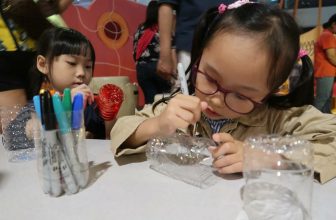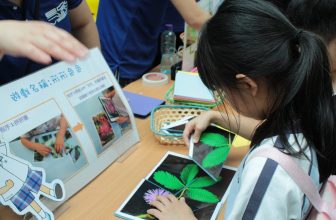
STEM+ Education Preliminary Series
I have written about the development of STEM education in China and also talked about the situation in the United States. First, of course, because the United States is the source of STEM education; second, the two powers of China and the United States will continue to compete with each other in future generations. The comparison of technological developments promoted by STEM education between the two countries will be a relevant factor in the strength analysis; third, the United States STEM Education has not been as popular in China, Southeast Asia and Nordic countries in recent years. Readers are also interested in learning about the latest developments in STEM education in the United States. Due to space limitations, this article summarizes some online materials and a brief introduction to the manuscripts of the discussion platform.
U.S. roadmap for advancing STEM
The author of this “STEM + About Educational Series” the first paper document – the <STEM turned out> has been Introduction to American STEM education is actively promoted by the US government. Here is an excerpt from the manuscript of the author Wang Feng in the “Shanghai Education Global Education News” on August 3, 2017-“STEM Education in the United States”, and I will add in sequence:
In 1986, the National Science Council of the United States published the “Undergraduate Science, Mathematics, and Engineering Education” report, which is considered a milestone in the integrated strategy of STEM education in the United States. For the first time, the report clearly put forward programmatic recommendations for “science, mathematics, engineering, and technology” education, which was regarded as the beginning of STEM education.
In 1996, the National Science Foundation of the United States published a report entitled “Shaping the Future: Perspectives on Undergraduate Education in Science, Mathematics, Engineering, and Technology”, and proposed future “action guidelines” to vigorously “cultivating STEM education in the K-12 education system” The problem of teachers.”
On January 31, 2006, in his State of the Union address, US President Bush announced an important plan-the American Competitiveness Initiative (ACI), and proposed that one of the educational goals in the era of knowledge economy is to cultivate STEM literacy. Talent, and call it the key to global competitiveness.
On October 30, 2007, the National Science Council of the United States issued the report “National Action Plan: Responding to the Urgent Needs of the American Science, Technology, Engineering, and Mathematics Education System”. The proposed action plan mainly includes two measures: one is to require enhancement At the national level, the leading role of K-12 and undergraduate STEM education should be coordinated horizontally and vertically; the second is to improve the level of teachers and increase the corresponding research investment. This report shows that STEM education extends from the undergraduate level to the elementary and middle school education stage. It is hoped that STEM education will be implemented from the elementary and middle school.
It was also in 2007 that the U.S. Senate and House of Representatives unanimously passed the “U.S. Create Opportunities to Meaningfully Promote Excellence in Technology, Education, and Science Act” (also known as the “U.S. Competition Act”) on August 2. The emphasis placed on STEM education by the “American Competition Act” to a large extent reflects a common concern in American society.
On January 11, 2009, on behalf of the NSF, the National Science Board issued an open letter to President-elect Obama of the United States, the subject of which was “Improving Science, Technology, Engineering, and Mathematics Education for All American Students.” It is clearly pointed out that: the country’s economic prosperity and security require the United States to maintain a leading and guiding position in science and technology in the world. STEM education before university is the foundation for establishing leadership, and it should be one of the most important tasks of the country.
In 2011, President Obama launched a new version of the “American Innovation Strategy” aimed at ensuring economic growth and prosperity. The new version of the “American Innovation Strategy” points out that the future economic growth and international competitiveness of the United States depend on its ability to innovate. The “Innovative Education Movement” guides the joint public and private sectors to strengthen science, technology, engineering, and mathematics (STEM) education. In the same year, the National Academy of Sciences Research Council issued the report “Successful K-12 STEM Education: Confirming Effective Ways for Science, Technology, Engineering, and Mathematics.” The report concluded that there are three main goals for implementing STEM education in primary and secondary schools:
- Expand the number of students who will eventually pursue advanced degrees and work in the STEM field, and expand the participation of women and minorities in the STEM field;
- Expand the workforce with STEM literacy and increase the participation of women and minorities in this workforce;
- Enhance the STEM literacy of all students, including those who are not engaged in work related to STEM careers or students who continue to study STEM subjects.
In December 2011, the Association of Governors of the United States released the report “Developing the Science, Technology, Engineering, and Mathematics Education Agenda: State-level Action Update” for the STEM education initiative, which analyzed the weaknesses in the action agenda proposed by the Association in 2007 , To re-propose various specific measures for the “Implementation of the State-level STEM Agenda.”
Four literacy of American STEM education
Wang Feng pointed out in the manuscript that STEM education is a kind of “post-discipline”, that is, the establishment of this discipline is based on the integration of different disciplines and then forms a new whole, which forms a whole from the originally scattered disciplines. Cross-field STEM education that is becoming more and more important today. The fundamental reason why the United States attaches great importance to STEM education is that it deeply recognizes that the decline in American science and technology lies in its serious shortage of talents. This has been repeatedly mentioned in a large number of documents in the United States in the past 10 years, and talent preparation focuses on training students. Kind of STEM literacy:
First, scientific literacy. It is the use of scientific knowledge and processes to understand the natural world and participate in relevant decision-making that affects the natural world.
Second, technological literacy (Technological literacy). Refers to the ability to use, manage, understand and evaluate technology. Technology is the innovation and transformation of the natural environment to meet people’s actual needs.
Third, engineering literacy. Refers to the understanding of the engineering design and development process of technology. Engineering courses are based on projects and integrate knowledge from multiple disciplines, making difficult-to-understand concepts closely related to students’ lives, and inspiring students’ interest in problem-solving.
Fourth, mathematical literacy (Mathematical literacy). Refers to the ability of students to analyze, infer and effectively communicate ideas when discovering, expressing, explaining and solving mathematical problems in a variety of situations.
Everyone knows that the STEM education initiated by the United States later became STEAM with the addition of Arts. Some regions and organizations have evolved into STREAM, and the extra R refers to reading and writing. In the future society, reading and writing are extremely important teamwork and communication skills.
Specific Practice of STEM Education in the United States
US support for STEM is nationwide. The White House held the Maker Faire for the first time on June 18, 2014 (National Day of Making). At the event, Obama also announced the overall measures to promote the Maker movement led by the White House. Many organizations and companies have agreed to support this “mass renaissance of American manufacturing” that promotes makers in various forms.
Although the core of American STEM education is S, T, E, and M, the content of extension is very rich, including language art, business skills, including PR, Marketing, teamwork, and coopetition, which is very important today. The compound word is a combination of cooperation and competition, meaning “competition”.
Another wonderful extension of American STEM education is to value the self-confidence that education brings to children, so that children can obtain the skills and confidence to face future challenges, and gain the respect of others and the true growth of their hearts without paying too much attention to results. This is the essence and core of STEM education. It needs to be fully understood and understood by domestic science and technology educators and STEM education learners. Only in this way can we truly cultivate talents with competitiveness in the future.
STEM education has become an independent curriculum in the United States, emphasizing the comprehensive application of knowledge in four subjects, and emphasizing the ability to solve practical problems. STEM education in the United States is gradually infiltrating elementary and middle schools from undergraduates and high schools. It has very advanced educational concepts behind it, including all the elements needed to cultivate talents for the 21st century:
- Enough environmental conditions
- Student-centered activity design
- Focus on learning in real situations
- Corporate learning model
- The school builds a digital campus
The Dilemma and Challenges of American STEM Education
Although it is highly valued, the current situation of STEM education and STEM talents is worrying. The United States pointed out in a “Human Resources Survey Report” published in 2011: More than half of American employers find it difficult to find employees with advanced mathematics, advanced physics, and advanced chemistry knowledge, but this knowledge must be mastered at work. of. The Siemens report stated: In 2012, the company originally planned to recruit more than 3,000 employees in the United States, but found that only 10% of the applicants successfully passed the STEM competency test, which means 90% of the applicants Failed to obtain the ability to be competent for these 3,000 positions from school education. Therefore, experts predict that in the next ten years, the United States must train 1 million more college graduates in STEM fields to make the US economy invincible. Corresponding to the lack of STEM talents is the rapidly increasing demand. In the United States, the growth rate of STEM jobs is three times that of other jobs. There is another thing that may impress graduates who are looking for jobs more: Salaries in STEM-related industries are usually 26% higher than in other industries.
The conclusion drawn from the above statistics is that all students must obtain a high-quality STEM education at the K-12 stage, regardless of whether they want to go to university or enter the workplace to earn a living. Therefore, the United States must provide K-12 students with STEM courses that are both lively and interesting and can be enjoyed by more people. Otherwise, the status of the United States as an economic power today will be precarious.
Looking at the current actions to promote STEM in various parts of the United States, there are two obvious characteristics in implementation at the operational level. One is to embrace digital technology, and the other is to learn in real situations.
The hardware conditions for STEM landing in China are available. Good schools have 3D printers, lathes, drilling machines, and so on. The lack of teachers is a soft condition. People are the core link in STEM education, and the United States also faces common problems. At the STEM+ Education Shanghai Summit in November 2016, Professor Juliana Texley from Central Michigan University/Lesley University in the United States proposed: “A channel connecting the future should be opened up to help students in today’s world grow into excellent citizens of tomorrow’s world. To better meet the challenges of the future:
Challenge 1: Teachers find it difficult to integrate STEM
When teachers themselves are in the knowledge acquisition stage, they also receive traditional subject-based education, from the lack of science curriculum in elementary school to being taught by single subjects in university, and the differentiation of textbooks and subject books. This kind of solitary education This method has resulted in the weakness of teachers themselves in collaboration and integration capabilities. The concept of interdisciplinary integration is the biggest challenge faced by teachers. An important action taken by the United States to challenge integration is to redefine success, which has forced educators to change and try to develop a three-dimensional teaching integration curriculum.
Challenge 2: Technical realization
At present, basic education does not have a systematic and complete technical curriculum, but today’s children are technically aborigines, and they look forward to better technical education courses. This challenge is more obvious not only in the United States, but in China. Many of the same domestic fields lack sufficient technical and hardware support, especially in rural areas.
Challenge 3: Integrate literature to state STEM ideas
Different from traditional literary concepts, Professor Juliana Texley proposed that proper reading is of great value to understand STEM education. STEM literature is very different from traditional science books. It involves active investigation and sharing of thinking habits, which represents the innovation of STEM.
Challenge 4: Build the confidence of teachers
In fact, all teachers have done a great job in the courses they teach. Professor Juliana Texley believes that it can help them build better confidence in the education methods they are already familiar with. For example, let teachers and schools effectively evaluate what they are currently using and the textbooks they want to use; give teachers the right to formulate and evaluate their own courses, instead of using a unified evaluation standard system to limit each individual’s strengths.
STEM 2026: Six Visions of American STEM Education Innovation
In order to further promote STEM education, on September 14, 2016, the American Research Institute and the U.S. Department of Education combined the seminar participants’ visions and suggestions for the development of STEM in the next ten years, and jointly released: “Innovation Vision in Education” (STEM 2026) : A Vision for Innovation in STEM Education). “STEM 2026” aims to promote the research and development of STEM education innovation and provide a solid basis for it. Ensure that learners of all ages and types can enjoy high-quality STEM learning experience, solve the problem of equity in STEM education, and maintain the competitiveness of the United States.
The six visions of American STEM education are:
- Networked and highly engaged community of practice
- Join specially designed games and risky learning activities
- Contains educational experience in solving the “big challenge” with an interdisciplinary approach
- Flexible and inclusive learning space supported by innovative technology
- Innovative and operational learning measurement
- Promote a diversified and multi-opportunity social and cultural environment
The “STEM 2026” report also mentioned that there are six types of technologies that may disrupt the STEM classroom in the future:
- Online collaboration tools
- Online hybrid education environment
- Immersive media
- Simulation game
- Smart tutor system
- Augmentation and Virtual Reality AR&VR
4 latest endeavors and the “Polaris” project
In June 2018, the White House Office of Science and Technology Policy selected and invited outstanding contributors and leaders in STEM education from all states to a intensive discussion. The meeting put forward four newest endeavors for STEM education in the United States and released related reports.
- Build a stronger connection between education and work
- Focus on innovation and entrepreneurship
- Integrate computer science into STEM education
- Develop a plan to improve STEM literacy for all Americans
The White House went further and released a five-year strategic plan for STEM education on December 3, 2018-the “Polaris” plan, which was drafted by the National Science and Technology Council STEM Association and the White House Office of Science and Technology Policy. The plan heralds the future investment direction of the US federal government, and also urges educators to launch more meaningful and enlightening STEM courses: PBL learning, science festival, robot club, invention challenge and study tour workshops, etc., any comprehensive application that can cultivate students Knowledge of various fields to identify and solve problems. This goal of the government has three implications:
- Increase breadth: Every American should master basic STEM concepts (such as computer thinking) in order to be able to cope with technological changes;
- Increase the depth: enhance the learning of STEM by students who were previously lacking in this field;
- Encourage the next generation: Encourage students to pursue STEM careers.
Hot outside and cold inside, good STEM starts with research.
Although the United States is actively investing and promoting STEM education across the country, basic education in recent years has shown a “hot outside and cold inside” situation. A research institution dedicated to educational innovation in the United States collects education big data through multiple channels. Earlier this year, it released the “2018 U.S. Education Trends” report, revealing the 20 educational development trends that American educators are most concerned about today. As a result, it helps to cultivate a positive attitude for children to face difficulties and challenges. It will also rank first in the “growth thinking” that stimulates more active brain activities to improve children’s IQ. PBL (project-based learning/special study) is also on the list, ranking sixth.
Surprisingly, the STEAM education that people have been paying attention to is not included, but the related maker teaching, robotics and programming learning are on the list. Scholars interpret that perhaps STEAM education itself has the complexity of interdisciplinary knowledge integration, the uncertainty of interdisciplinary cross-border, and the huge challenges to the school curriculum, teacher curriculum development and design capabilities, which lead to the fact that the educators who really pay attention to it do not More, less practice in the classroom. The reality shows that although the concept of STEAM education is exciting, it does have a huge role in cultivating students’ innovation and practical ability. There is a problem of inadequacy between its internal requirements and the actual education system. Many of the so-called “STEAM education” in China today are in fact only replicas of labor technology disciplines or small inventions and small creations, but they are packaged to cater to today’s hot spots.
How can we manage STEM education well? Perhaps STEM educators in the United States, China, and Hong Kong should refer to this year’s “Yidan Educational Research Award” winner, Professor Larry Hedges, head of the Department of Statistics at Northwestern University, Chicago. Do relevant research first.” This is exactly in line with the characteristics of STEM education of “teaching indefinite methods, learning indefinite methods, and becoming indefinite methods”.
Author: Lin Guiguang
Art education administrative staff, in charge of school inspectors of the Education Bureau and curriculum development for primary and secondary schools for 30 years, familiar with curriculum and learning activity design. In my spare time, he explores the development of modern fiber art and digital art, and explores topics such as “knowledge management” and “mobile learning”. Chairman of the Asia-Pacific Art and Creative Education Exchange Association, consultant of Guangzhou Children’s Palace Children’s Art School, STEM strategy consultant of the Ministry of Information Technology Education affiliated to PCCW, founding chairman of the Hong Kong Art Education Association, and first director of the Friends of Hong Kong Museum of Art.
Reference source: www.master-insight.com






